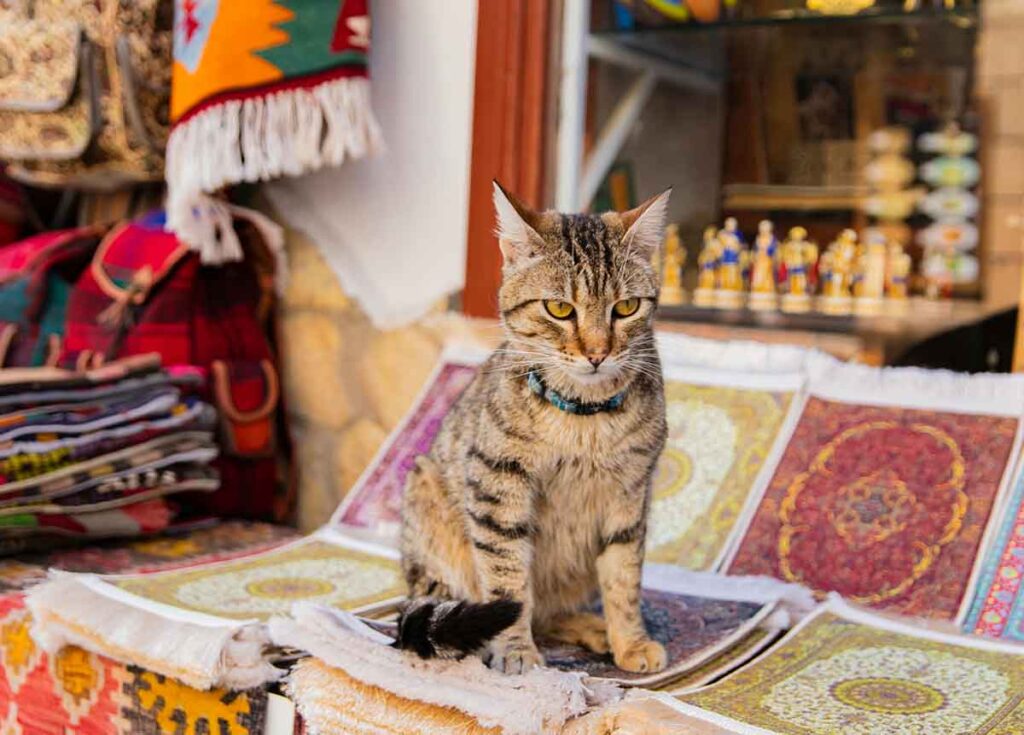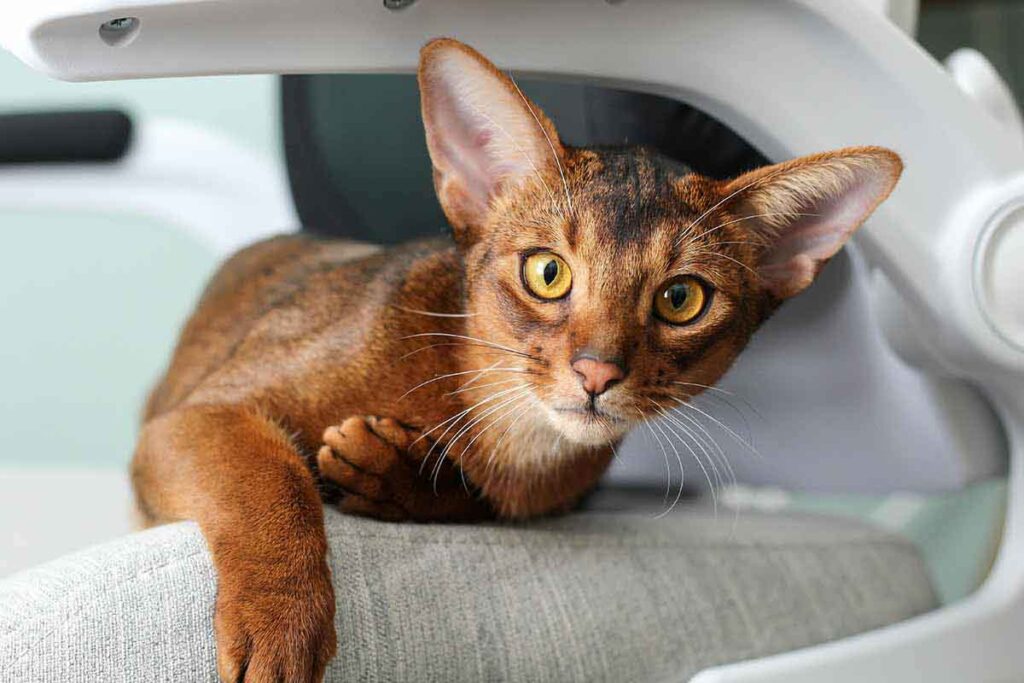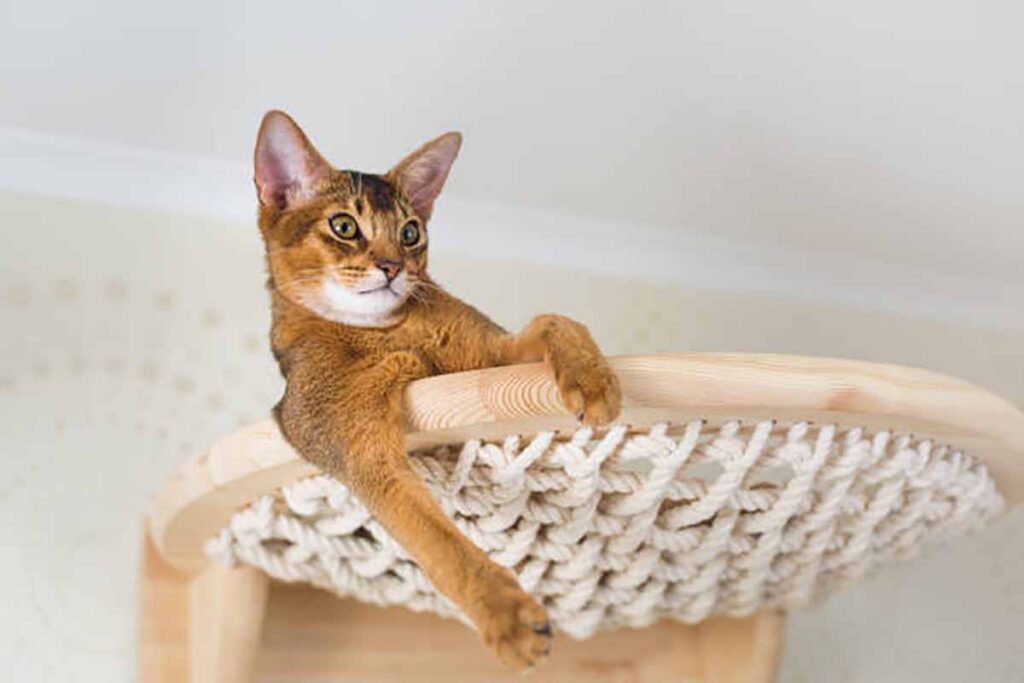This cat breed is distinguished by its mobility and sociability.They never let go of their claws while Abyssinian cats are medium sized animals.They are small, muscular and athletic.The code is close to the short thin skin, the Abyssinia cat is a very ancient animal.The first representatives of this breed were in the presence of Ethiopia.It was then called Abyssinia.
This breed of cat is distinguished by a beautiful and muscular body as well as long and narrow paws.On top of which there is a soft elongated pad.Their tails are very long and their necks are of medium length.From above, the head of such cats appears to be wedge-shaped.It has beautiful large ears that some animals may have small tassels on the tips.
Abyssinia comes in a variety of colors.Recognized in a total of four colors, this cat is very intelligent and mixes well with sociable children.Perhaps the only downside is that he doesn’t like to have it.So spend as much time with him as you can and take the time to play with your cat or rest to be with the animal.
Adopting from a rescue organization or shelter is recommended before bringing your cat home or giving the cat a loving home.However if you decide to buy your beloved Abyssinian kitten you should choose a reputable breeder.
e they play with the little ones and the big ones.Abyssinians’ voices are so thin and quiet, respectively, that they will not disturb their owners too much.
By their true nature these beauties are quite curious and obviously they love to explore everything. Abyssinian cats behave somewhat like dogs, except they are loyal, affectionate and playful.
Characteristics of the Abyssinian Cat
Abyssinian cats have an average lifespan of 12 to 15 years. Each breed has its own specific external characteristics and temperament.Of course every animal is unique and its behavior is not based solely on genetics.Below are the characteristics of Abyssinia.
- Body: Small, flexible and muscular.
- Head: Moderately wedge-shaped with rounded contours.
- Muzzle: With a slightly curved, softly contoured profile.
- Neck: Refined.
- Ears: Wide at the base, widely spaced, round brush at the ends and a thumbprint mark on the outside of the ear is preferred.
- Spout: Hard
- Nose: Of medium length.
- Eye: The eyes are widely spaced, more expressive, almond-shaped.Amber to green color with black lining around the eyes.
- Paws:Oval narrow.
- Limbs: Long slender with well developed muscles.
- Tail: Thick at base long and tapering at tip.
- Wool: Short very thin sheen fits tightly to the body. A short thick and elamistock undercoat.
- Size: 6 to 10 pounds.
- Color: The standard recognizes four main shades. ruddy, sorrel, fawn, blue.
- Lifespan: 9-15 years.
Abyssinian History
Abyssinians have been found next to pictures of pharaohs.Modern genetic data prove that the first cat of this species appeared in the Indian Ocean or in the region along the coast of Southeast Asia.British and Dutch merchant seamen could have brought them from there.Brought to America from England in the early 20th century, this breed is among the five most popular cat breeds in the United States.
The origins of the world’s oldest cat breeds are shrouded in myth and legend.According to one of them, the king of Abyssinia gave the Egyptian pharaoh a cat that looked like a Barbary lion.At first sight he fell in love with this small creature with a majestic posture and exotic appearance.
According to scientists, the ancestors of the Abyssinian cat lived in Egypt.In fact, Abyssinia is considered to be the birthplace of the Abyssinian cat.The breed was officially recognized in England at the end of the 19th century.In 1907 they were brought to the United States.
During World War II many animals died and the breed was almost lost.At that time only about 12 cats survived in all of Europe, but the breeders were able to reproduce by crossing with other breeds from the surviving representatives.
This resulted in a slight change in the breeding standards and they were later changed from the 1889 standard.
Abyssinian Behavior

The Abyssinia cat is an intelligent cat.Specifically said that I senior cat lying on the sofa, they carefully observe what is happening around.Seeing that they do this behavior reminds you of your dog because cats are energetic and playful.
They are purposeful, curious and active creatures, but at the same time tactful and attentive.Friendly, this intelligent has a good memory, they are attached to their owners and love praise.
If there is a child in the family who grabs the animal, your Abyssinia cat does not release its claw.Understands his tender age but does not forget the insult and avoids the child.Abyssinia voice is sweetly calm and does not irritate like thin bells.
This is a very active cat who loves to spend his time playing or exploring.For this reason anyone would want to keep an animal of this breed at home.This cat is very intelligent and sociable, gets along very well with children especially it is said that the behavior of this Abyssinia cat is friendly.Cats are not afraid of water and bathing them is not difficult.
Abyssinian Color Options

Pedigree Abyssinians have a warm and watery coat color,The multi-colored stripes on the hair affect each other.Blends into a partan, and sparkles.Abdomen, inside of legs, sides and chest uniformly colored.A dark “strap” runs along the entire spine, leading to the tail.Abyssinian cat skin colors are very beautiful.
Abyssinian Cats Have Only Four Main Colors:
- Rruddy
- Sorrel
- Blue
- Fawn
Ruddi : Classic color was considered the only recognition until 1963.The most common, ocher, dark brown or black shades, have a double or triple ticking without a specific pattern. The black spots are only on the face and tip of the tail. The hair below the undercoat structure is orange. The inner surface of the legs and the lower abdomen do not conflict with others in color.
Sorrel: Sorrel color varies from reddish brown to copper red. Can be cinnamon or apricot. The guard’s hairline is red. The color of the inner surface of the paws and abdomen is consistent with the main. Chocolate-brown areas are clearly visible on the face and tail. The dark tip of the nose is almost not visible, the paw pads are dark pink.
Blue : From above, from head to tail, the coat is colored in pleasant gray-blue tones, becoming a steel shade. Belly, inside paws and undercoat – a warm pinkish-beige, apricot shade. Tail bluish, nose brick red, with blue tips. Slate markings stand out on the face and tail.
Fawn: Cocoa color tonality is a light brown shade with a pink undertone, like coffee with milk. The nose is a dry rose color, with a lilac edge. Rare due to recessive genes.
Abyssinian cat colors are very beautiful, if you want to get your favorite cat then you can choose the color you like.
Health and Diseases of the Abyssinian Cat
Before bringing an Abyssinian cat home, you need to know about the cat’s health first.Keeping cats healthy is a particularly important task.Cats can have a better life through cat wellness.
Just as you need to be aware of your cat’s health, you also need to be aware of your cat’s illness. Care should be taken to ensure that no disease can invade your cat’s body.It is your responsibility to give your pet cat a healthy and beautiful life.
Abyssinia lives 9-15 years with proper care.
However, representatives of this breed are prone to several hereditary diseases.
Below are The Diseases
- Pyruvate kinase deficiency. Abyssinian and Somali cats are most prone to pathology. Pyruvate kinase is an enzyme responsible for producing energy in erythrocytes (red blood cells). Cats with this pathology develop anemia. This disease is accompanied by lethargy, loss of appetite and jaundice of the skin. It is detected through screening tests.
- Renal amyloidosis. The pathology is characterized by a violation of protein metabolism in the kidney, which leads to renal failure.
- Progressive atrophy of the retina. A degenerative disease that leads to blindness. Common symptoms: Refusal to walk stairs, fear of dark rooms.
- Dislocation of the patella. Hereditary disease is manifested by limitation of mobility. There are different intensities. In severe cases, it is treated with surgery.
- Spontaneous hyperesthesia syndrome. Neurotic disorders, where the cat is in constant tension, have increased pain sensitivity. Inadequately responds to touch.
- Psychogenic alopecia. Behavioral disorders. The cat licks and scratches very intensively, which leads to hair loss and the development of dermatitis.
In Addition to Genetic Pathologies, Abyssinian Cats are Prone to The Following Diseases
- Periodontitis. Cats are prone to early development of gum disease. It is important to carefully care for the oral cavity, to visit the veterinarian on time.
- Allergy Abyssinian is an allergic breed. Often, food reactions are revealed.
- Genetic amyloidosis. Along with it, metabolic processes and immune system functioning are disturbed. The first symptoms are thirst, weight loss, unusually frequent urination, vomiting and persistent dental problems.
- There is a dermatitis that is not inherited. It is a neurological disease that leads to hair loss due to stress and constant licking.
- Malnutrition causes swollen gums, gingivitis. Prevention requires proper nutrition and dental care.
- All Babies are susceptible to leukemia, but this incurable disease is preventable by vaccination.
The first vaccination for kittens is carried out at 9-11 months, earlier it is impossible, there are teeth changes. Further – Annually. Vaccinate against panleukopenia, herpesvirus infection, calicivirus, chlamydia, leukemia, immunodeficiency, viral peritonitis, shingles and rabies.
So it is important to be aware of your pet cat’s health and diseases. Take care of your pet cat and give it a healthy life.
Description of Abyssinian
Abyssinian cats are small in size.It is a distinguished animal of small stature, majestic posture, lithe and well-muscled. Have a penetrating look, thoughtful and wise. Cats are sociable, agile, unpretentious, they are friends with children and other animals in the house.
The features it has developed will help determine the genus.
- Animals weigh 4 to 7 kg, and cats are larger and heavier than cats.
- Girls wither up to 28 cm, boys – up to 32 cm.
- He head is shaped like a slightly rounded wedge, with a soft line of cheeks and eyebrows. A slightly convex and wide forehead flows smoothly to the crown and back of the head, the neck is beautiful, short, curved.
- The ears are large, moderately pointed and darkened at the tips, widened at the base, they take a cup-shaped contour. Some individuals have tasseled ears at the tips.
- The eyes are large, almond-shaped, with a shiny, thoughtful look. The hair around the eyes is light, with a dark line along the contour, like a woman’s eyeliner. The iris is juicy, dominated by golden tones, orange-yellow, amber, hazel, sometimes light green. All kittens have blue eyes.
- The body is elastic, beautiful, medium in length, with well-developed muscles that do not weigh it down. The proportions are perfect.
- Limbs are lean and elegant. Paws short, oval.
- The long tail tapers towards the tip, and thickens noticeably at the base.
Dense fur is pressed against the body, burning brightly. The color is reminiscent of the sands of Egypt and Ethiopia. The texture is silky, springy under the fingers and abundant, the undercoat is light. There are several ticking lines along the length (changing color). In each hair, each other is replaced by lighter and darker shades.
Abyssinian Food

This breed is not prone to gluttony, overeating or obesity. Food quality is important. You can feed Abyssinians both ready-made dry or canned and natural products. Some breeders recommend a factory diet balanced with vitamins and minerals, as well as dry kibble to clean the teeth.
Pates and various tasty pieces are not very good. Soft food stays between the teeth for a long time and causes gum problems. Dry food is selected by age, it should be with a lot of protein and dietary supplements.
- When using fresh products, boiled, raw or frozen meat is introduced to the menu. The norm for an adult is 120 grams, for a kitten – 30 grams.
- Small kittens eat 4 times a day, small portions. In a year they switch to three meals a day, and one and a half to two meals.
- Chicken breast and turkey are given daily, beef and veal – three times a week. Completely exclude pork, lamb and duck.
- Dairy products are fed daily.
- Alternate vegetables and porridge, mixed with meat.
- Boiled sea fish, egg yolk, beef liver, chicken heart are given twice a week.
- Abyssinians are vegetarians who prefer raw vegetables and fruits. Feel free to give them fresh apples, carrots, watermelon, cauliflower and cucumbers.
- Each day, bio additives and ½ teaspoon of olive or sunflower oil are added to the food.
- Water is changed 2 times a day, but they prefer to drink from the tap.
Prohibited Foods: River fish, beef kidneys, pork, sausages and all similar products, salty cheese, sweets and some fruits, sour cream and cream, egg whites are strictly prohibited.
When choosing one type of food, for example, natural food, canned food or dry elite food, you should not mix it with other types of food.


